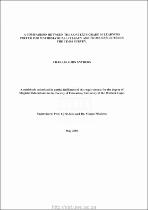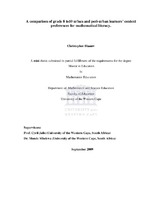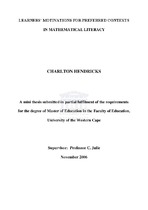A comparison between the contexts Grade 10 learners prefer for Mathematical Literacy and those reflected in the TIMSS survey
| dc.contributor.advisor | Julie, Cyril | |
| dc.contributor.author | Snyders, Charles John | |
| dc.date.accessioned | 2023-06-01T09:21:39Z | |
| dc.date.available | 2023-06-01T09:21:39Z | |
| dc.date.issued | 2006 | |
| dc.identifier.uri | http://hdl.handle.net/11394/10067 | |
| dc.description | Magister Educationis - MEd | en_US |
| dc.description.abstract | This study focuses on the contexts grade 10 learners prefer to deal with in mathematical literacy. These preferred contexts of the learners were then compared with the contextual situations found in the Third International Mathematics and Science Study (TIMSS). The most important findings of this study are that grade ten learners from low socio-economic environments regard mathematics and mathematicians' practices as the most favoured items. The extra-mathematical clusters that they prefer are the technology and health cluster. TIMSS designers favoured the financial cluster flavored with youth cultural elements and technological devices that the youth are associated with. What learners find relevant or interesting may differ from what designers of tests may perceive to be relevant or vice versa. UN | en_US |
| dc.language.iso | en | en_US |
| dc.publisher | University of the Western Cape | en_US |
| dc.subject | Mathematical Literacy | en_US |
| dc.subject | Contexts in Mathematics | en_US |
| dc.subject | Mathematical Modelling | en_US |
| dc.subject | TIMSS | en_US |
| dc.subject | Relevance of Mathematics | en_US |
| dc.subject | Learners' interest in Mathematics | en_US |
| dc.subject | Relevance of School Mathematics Education (ROSME) | en_US |
| dc.title | A comparison between the contexts Grade 10 learners prefer for Mathematical Literacy and those reflected in the TIMSS survey | en_US |
| dc.rights.holder | University of the Western Cape | en_US |




